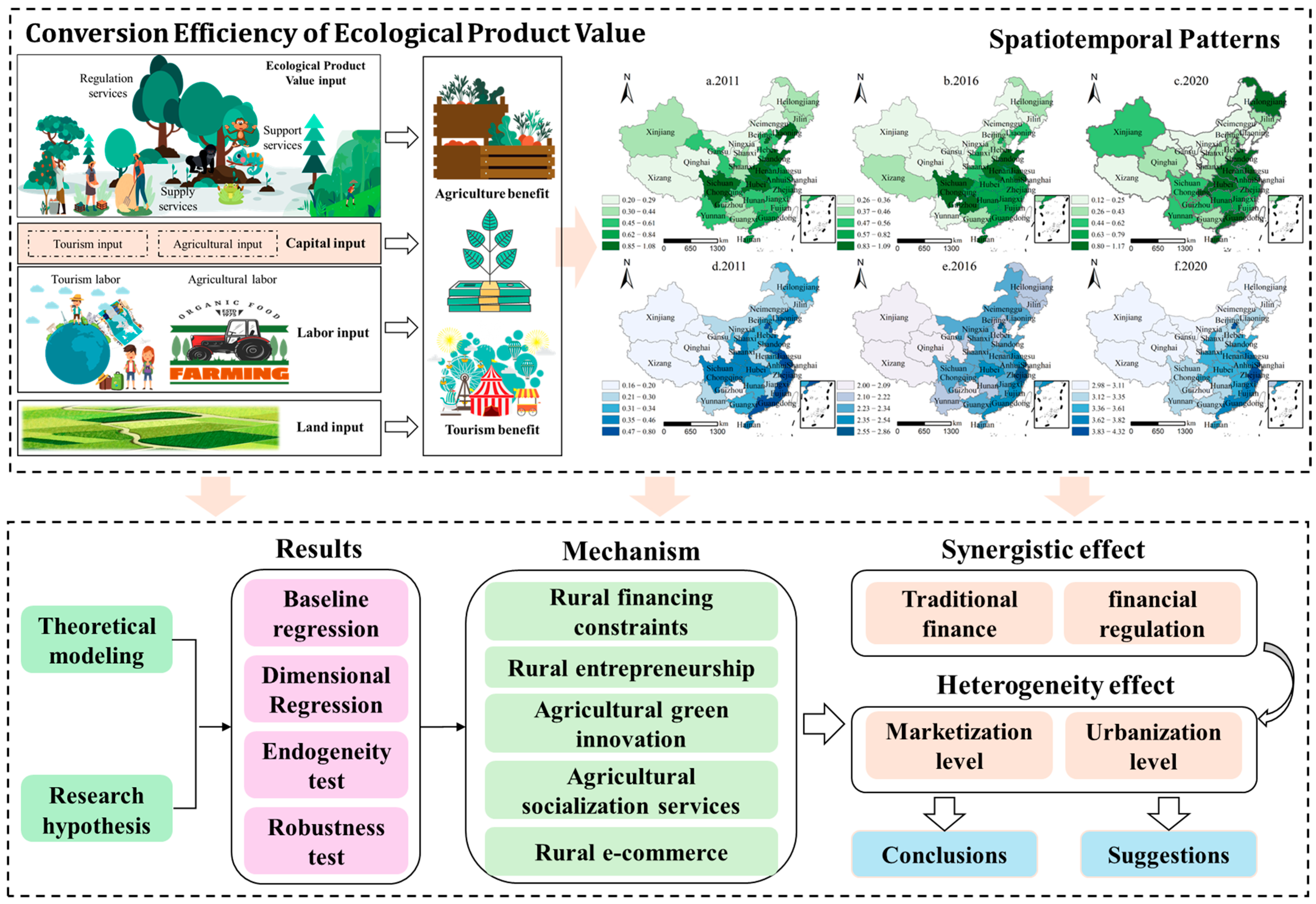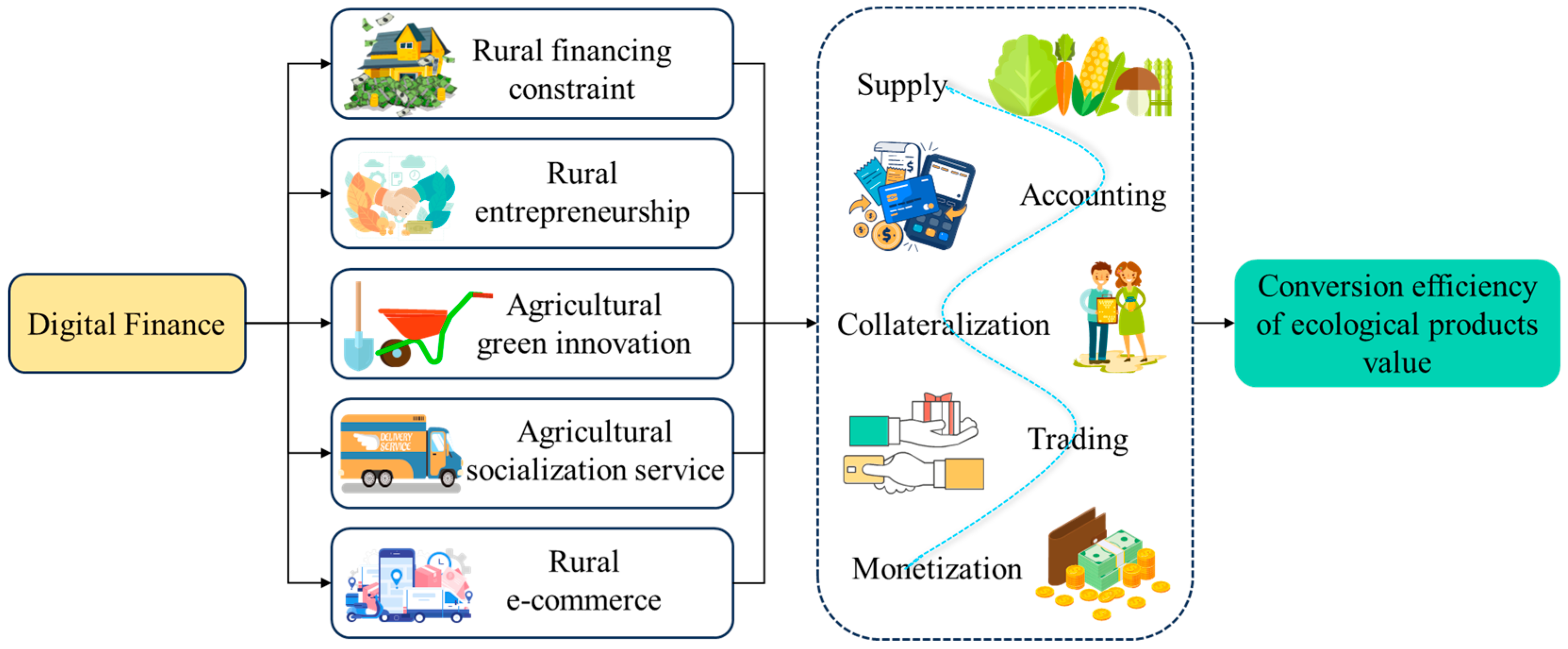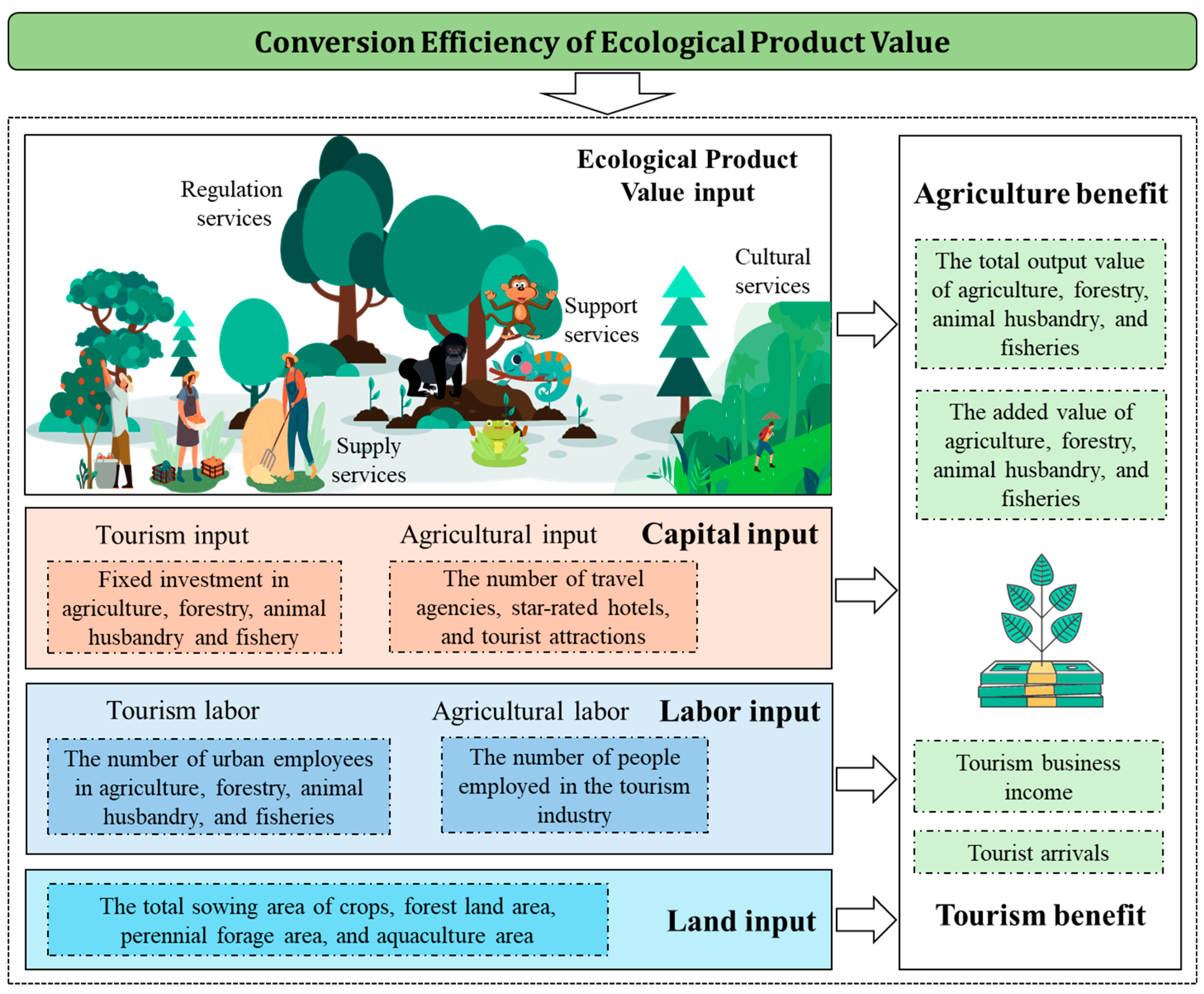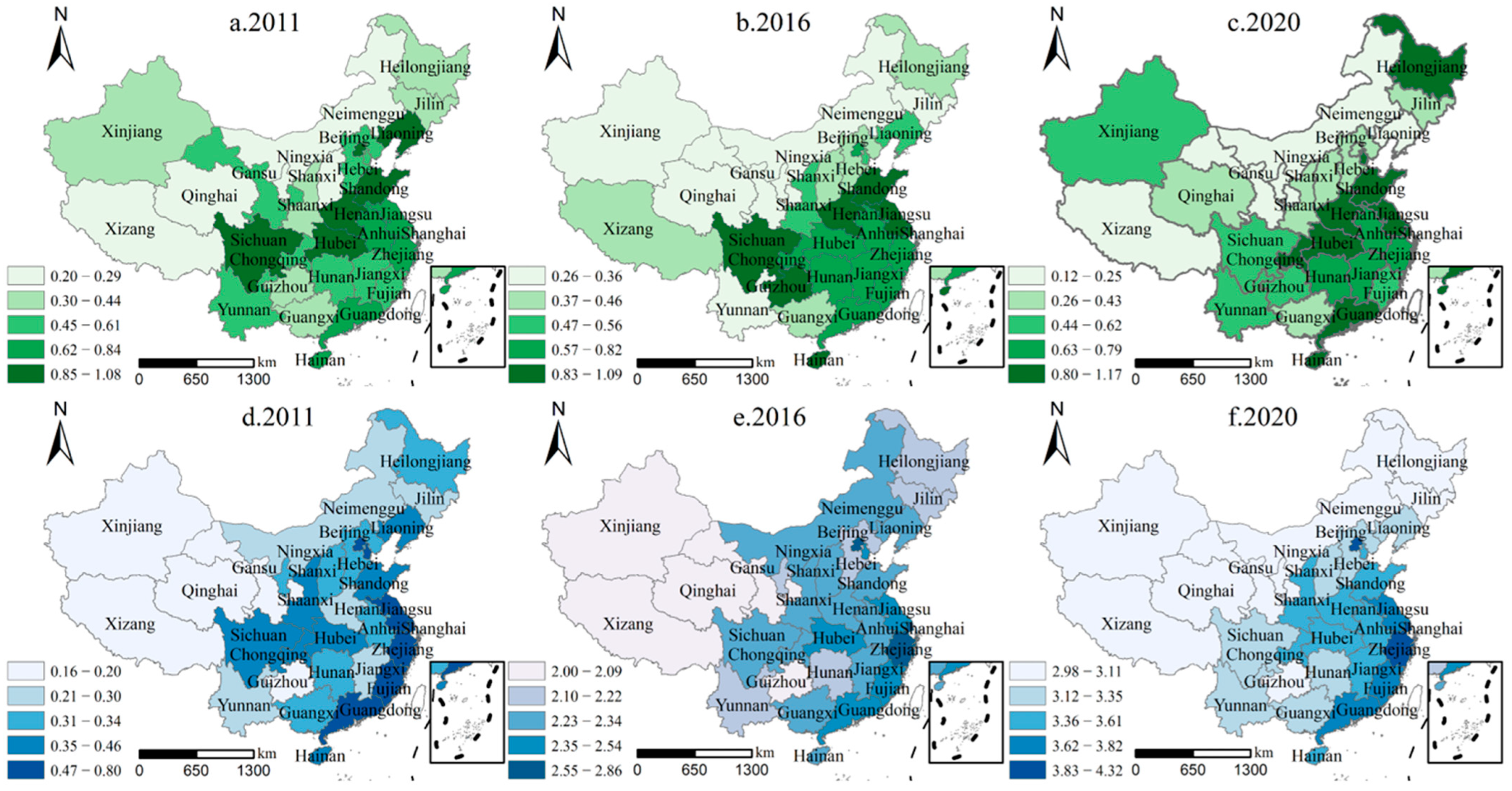2.1. Literature Review
The concept of ecological products, derived from ecological services and introduced by Ehrlich and Ehrlich (1981) [
17], refers to the welfare that humans derive from ecosystem functions. Costanza et al. (1997) [
2] further clarified that ecological products are obtained either directly or indirectly from ecosystem functions. The Millennium Ecosystem Assessment [
18] categorized these benefits into four groups: provisioning, regulating, supporting, and cultural services. Realizing the EPV requires the implementation of government or market mechanisms to transform ecological products into production factors that are integrated into the market economy. EPV accounting are crucial areas of research in the realization of EPV. Currently, the main methods for EPV accounting include the equivalent factor method [
19,
20], the market value method [
19], the function pricing method [
21], and the “eco-yuan” approach [
22].
Existing research on the realization of ecological product value has made some progress, primarily focusing on theoretical discussions and case analyses, while studies that measure the realization of ecological product value remain limited. Notably, Kong et al. (2023) [
4] employed input factors such as forest ecological product value, forest land, material capital, and labor, with forestry added value as the output factor, to assess the efficiency of ecological product value conversion in Lishui, Zhejiang Province. Their findings indicate that the development of the digital economy can enhance the conversion efficiency of forest ecological product value. Similarly, Sun et al. (2024) [
19] assessed the EPV in 77 urban-rural integration development pilot zones by combining the market value method with the equivalent factor method, and empirically examined the impact of ecological product value realization on urban-rural integration development. While these studies have made preliminary strides in measuring and converting ecological product value, there is an urgent need for breakthroughs in understanding the mechanisms underlying ecological product value realization.
With the advancement of information technology, digital finance has emerged as a significant field of study. Existing research has explored the economic effects of digital finance from both macroeconomic and micro-individual perspectives, emphasizing its inclusive financial characteristics, such as alleviating information asymmetry, providing precise financial services, expanding coverage, and managing risk [
12]. However, research on the impact of digital finance on the realization of EPV remains in its early stages. This includes studies investigating the effects of digital finance on the financing constraints of rural areas [
6,
23], rural entrepreneurship [
23], agricultural green innovation [
24,
25], agricultural socialization services [
26,
27], and rural e-commerce [
28]. The connection between digital finance and CEEPV, particularly its underlying mechanisms, remains an area in need of further exploration.
2.2. Direct Impact Mechanism
Through design features such as lower transaction costs, broader service coverage, higher service efficiency, and improved user convenience, digital finance can facilitate the conversion of EPV across all five stages: supply, accounting, collateralization, trading, and monetization (
Figure 2).
On the supply side, digital platforms like online lending, crowdfunding, and micro-funding are expanding financing channels. These are especially beneficial for small ecological enterprises and rural initiatives, helping them secure startup capital or scale up operations more easily [
29]. Compared to traditional finance, digital finance reduces intermediary costs, making funding more accessible and affordable [
15].
In accounting, the use of big data and AI allows for more accurate valuation of both the market and social value of ecological products, helping lenders and investors make smarter decisions [
30]. Blockchain technology further improves transparency and trust by making transactions traceable and verifiable—critical for credible ecological value assessments [
12].
When it comes to collateralization, digital platforms offer flexibility by recognizing digital and nontraditional assets as collateral. This is a game changer for ecological enterprises that often lack conventional assets but hold valuable environmental capital. Digitization also speeds up the process and cuts down costs [
15].
For trading, digital finance provides user-friendly online platforms that connect producers directly with consumers, cutting out intermediaries and improving efficiency [
6]. Mobile payments and digital currencies enable cross-border transactions, broadening the market reach of ecological products [
28].
In terms of monetization, digital tools allow ecological assets to be digitized or tokenized, making them more liquid and easier to trade in broader markets [
29]. Additionally, platforms now offer diverse financial products tailored to ecological sectors, expanding monetization channels.
A practical illustration is the case of Guizhou’s Chishui bamboo industry, listed among the national “Typical Cases of Ecological Product Value Realization.” Supported by digital finance, local cooperatives accessed credit to expand ecological bamboo cultivation and leveraged e-commerce platforms for branding and online sales. This demonstrates how digital finance reduces transaction costs and broadens market access, thereby facilitating the conversion of ecological resources into sustainable economic value.
Hypothesis 1: Digital finance can significantly enhance CEEPV.
2.3. Indirect Impact Mechanism
Underdeveloped regions often possess rich natural resources and ecological environments, giving them great potential to convert EPV into economic gains while preserving ecological sustainability. However, realizing this potential is constrained by limited investment, lack of technology, poor infrastructure, and restricted market access. Digital finance can play a transformative role in addressing these barriers by expanding access to credit, reducing transaction costs, and integrating ecological industries into broader markets. Specifically, digital finance influences CEEPV through five indirect mechanisms: rural financing, entrepreneurship, green innovation, agricultural socialization services, and rural e-commerce. A representative case is the Anji white tea industry in Zhejiang Province, also included in the China’s “Typical Cases of Ecological Product Value Realization.” Digital finance products provided loans for ecological tea farming, while online platforms enabled direct trading and branding. This integration of finance and e-commerce not only expanded the market reach of ecological products but also significantly improved their conversion efficiency, exemplifying the indirect mechanism of rural e-commerce.
Rural financing constraints: Traditional financial institutions often fail to meet the financing needs of farmers and agricultural enterprises in remote areas. Digital finance, through mobile and internet platforms, has expanded access to financial services in such regions [
31]. Moreover, by leveraging big data and AI, these platforms can better assess creditworthiness and reduce information asymmetry, thus lowering risks and easing borrowing processes [
6]. This improved access to finance enhances investment in agriculture and ecological product production, increasing the efficient use of ecological resources [
23,
32]. In addition, Wang (2023) [
33] notes that digital finance encourages long-term investment in sustainable rural development, thereby improving the CEEPV.
H2a: Digital finance enhances CEEPV by alleviating rural financing constraints.
Rural entrepreneurship: Digital finance also supports entrepreneurial activity in rural areas. Platforms provide farmers with market insights, access to technology, and financing channels [
8,
23], allowing them to engage in ecological industries. This reduces entry barriers and encourages innovation. Farmers can thus participate more actively in ecological product supply chains, boosting supply and monetization [
24]. As a result, digital finance promotes rural entrepreneurship, enhances the structure and efficiency of ecological industry chains, and elevates CEEPV [
4,
5,
34].
H2b: Digital finance enhances CEEPV by promoting rural entrepreneurial activity.
Agricultural green innovation: Green agriculture often struggles with high costs and long investment cycles. Digital finance helps mitigate these risks by supporting collaborative R&D, and easing access to capital [
25]. This enables innovation in green farming technologies and encourages their adoption at scale. Through platforms that connect tech firms with farmers, digital finance supports the development and dissemination of sustainable farming practices [
24]. These innovations improve resource efficiency and increase EPV, further boosting CEEPV [
35].
H2c: Digital finance enhances CEEPV by fostering agricultural green innovation.
Agricultural socialization services: Digital finance platforms improve coordination and information flow along the agricultural value chain. Farmers, processors, and distributors can exchange real-time information and integrate resources more effectively [
26,
27]. This strengthens agricultural socialization services, which improve specialization, enhance supply chain efficiency, and optimize resource allocation. Ultimately, this leads to greater EPV and improved CEEPV [
32,
34].
H2d: Digital finance enhances CEEPV by improving agricultural socialization services.
Rural E-commerce: Rural e-commerce development often faces financing and data limitations. Digital finance reduces these barriers, enabling better matching between sellers and consumers of ecological products [
28]. E-commerce platforms support efficient promotion, transaction, and delivery of ecological goods. This not only raises EPV but also significantly boosts CEEPV by shortening supply chains, reducing intermediary costs, and expanding market reach [
5,
36]. The improved visibility and accessibility of ecological products increase their value and market performance.
H2e: Digital finance enhances CEEPV by supporting rural e-commerce development.










